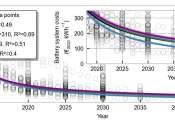An electric car is an alternative fuel automobile that uses electric motors and motor controllers for propulsion, in place of more common propulsion methods such as the internal combustion engine (ICE). Electric cars are a specifically a variety of electric vehicle intended for use as a road-going automobile. Electric cars are commonly powered by on-board battery packs, and as such are battery electric vehicles (BEVs). Other on-board energy storage methods that are expected to come into use in the future include ultracapacitors, or a spinning flywheel, which stores energy as potential energy.
Electric cars enjoyed popularity between the mid-19th century and early 20th century, when electricity was among the preferred methods for automobile propulsion, providing a level of comfort and ease of operation that could not be achieved by the gasoline cars of the time. Advanced in ICE technology soon rendered this advantage moot; the greater range of gasoline cars, quicker refueling times, and growing petroleum infrastructure, along with the mass production of gasoline vehicles by companies such Ford, which reduced prices of gasoline cars to nearly 50% of that of equivalent electric cars, effectively killed off the electric car in important markets such as the United States by the 1930s.
In recent years, increased concerns over the environmental impact of gasoline cars, along with reduced consumer ability to pay for fuel for gasoline cars, has brought about renewed interest in electric cars, which are perceived to be more environmentally friendly and cheaper to maintain and run, despite high initial costs. Electric cars currently enjoy relative popularity in countries around the world, though they are notably absent from the roads of the United States, where electric cars briefly re-appeared in the late 90s as a response to changing government regulations. The hybrid car has become the most common form of electric car, combining a gasoline powertrain with supplementary electric motors to run the car at idle and low speeds, making use of techniques such as regenerative braking to improve its efficiency over comparable gasoline cars, while not being hampered by the limited range inherent to current battery electric cars. Hybrids are now sold by most major manufacturers, with notable models including the Toyota Prius and the forthcoming Chevrolet Volt, a plug-in hybrid which uses a fully electric drivetrain supplemented by a gasoline-powered electric generator to extend its range. As of 2009, the world's most popular battery electric car is the REVAi, which is produced by an Indian company and sold in a number of countries in Europe and Asia.









